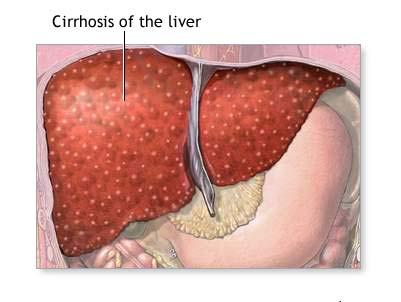
Symptoms of Cirrhosis of the Liver
Symptoms of Cirrhosis of the Liver
Cirrhosis of the liver refers to a condition characterized by the development of fibrous scar tissue on the liver and regenerative nodules or lumps. This chronic liver disease leads to progressive deterioration of liver function…
Liver function is vital to detoxification and protein synthesis, within the human body. It is responsible for the production of biochemicals that aid digestion. The organ can never be compensated for, with regards to function. The liver is an integral part ofmetabolism. It is responsible for the storage of glycogen, red blood cell decomposition, hormone production and plasma protein synthesis. It is not only the largest gland in the human body, but also the only one that produces bile to aid digestion.
Located just below the diaphragm, the liver regulates a number of biochemical reactions. Cirrhosis of the liver is commonly caused by alcohol abuse, hepatitis B and hepatitis C infection and the development of fatty liver disease.
Cirrhosis of the liver is associated with ascites or fluid retention within the abdominal cavity. The condition is life-threatening and associated with a poor quality of life. It not only exposes the patient to increased risk of infection, but also creates ideal conditions for the development of hepatic encephalopathy and esophageal varices bleeding. The condition is irreversible, with treatment options mainly focusing on the prevention of progression and further complications. Cirrhosis can be treated in advanced stages via liver transplant. The term ‘cirrhosis’ is Greek in origin, and means ‘tawny’ or orange-yellow color. René Laennec coined the name in 1819.
Symptoms of Cirrhosis of the Liver
The condition manifests in the form of signs and symptoms that occur as a direct result of cirrhosis or from the complications associated. The signs and symptoms include:
Vascular lesions due to increased estradiol.
Speckled mottling of the palm due to the resultant alteration of sex hormone metabolism.
Paired, separated bands visible on the nails due to low albumin production.
White nail plate with distal red due to hypoalbuminemia.
Painful proliferative periostitis of long bones.
Thickening of palmar fascia, accompanied by flexion deformities due to collagen deposition and fibroblastic proliferation.
Proliferation of glandular breast tissue in males due to increased estradiol.
Impotence, loss of sexual drive and testicular atrophy due to suppression of pituitary function.
Enlarged or shrunken liver size.
Increase in spleen size due to portal hypertension.
Fluid retention within the peritoneal cavity.
Shunting of blood from the portal venous system into the umbilical vein.
Venous hum in epigastric region.
Musty breath odor due to dimethyl sulfide increase.
Development of jaundice due to increased bilirubin.
Weakness and fatigue.
Anorexia and subsequent weight loss.
Facts About Cirrhosis of the Liver
Cirrhosis can manifest on account of more than one cause, in a single patient. The most common causes are alcoholic liver disease, Chronic hepatitis C and B, non-alcoholic steatohepatitis, biliary cirrhosis, sclerosing cholangitis, autoimmune hepatitis, hereditary hemochromatosis, Wilson’s disease, Alpha 1-antitrypsin deficiency, cardiac cirrhosis and/or cystic fibrosis.
The condition is best diagnosed via liver biopsy. The procedure involves a transjugular, percutaneous, fine-needle or laparoscopic approach. However, biopsy becomes unnecessary if radiology and laboratory data confirms cirrhosis.
Cirrhosis of the liver is characterized by typical clinical findings, such as elevated AST and ALT and alkaline phosphatase, elevated bilirubin with a drop in albumin level, increased prothrombin time, serum sodium, thrombocytopenia and coagulation defects.
Ultrasound is resorted to in the effort to evaluate the stage of cirrhosis, hepatocellular carcinoma and portal hypertension. The elastic waves generated help to detect liver stiffness. Ultrasound results are usually evaluated in conjunction with those of abdominal CT and MRI of the liver / bile duct.
Cirrhosis is defined by the presence of regenerating hepatocyte nodules and fibrosis. It also manifests in the form of liver injury caused by the infiltration of liver parenchyma by lymphocytes due to the onslaught of chronic hepatitis B. In the case of cardiac cirrhosis, the injury to liver tissue is caused by erythrocytes surrounding the hepatic veins, while in the case of biliary cirrhosis, the tissue damage is due to fibrosis, granulomas and bile pooling.